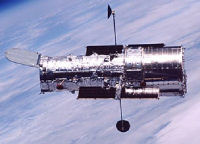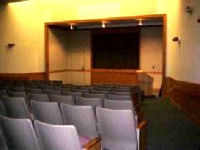 November 13, 2011 (San Diego) The public is invited to a unique presentation regarding the Hubble Telescope at the Mission Trails Regional Park Theater, by amateur astronomer in residence and Trail Guide member, George Varga, and Charles Carter, a Volunteer Entertainment Coordinator. They will present "Above the Ozone", a one-hour program featuring photos from the Hubble Telescope. The presentation takes place on Saturday evening, November 19, at 7:00 p.m.
November 13, 2011 (San Diego) The public is invited to a unique presentation regarding the Hubble Telescope at the Mission Trails Regional Park Theater, by amateur astronomer in residence and Trail Guide member, George Varga, and Charles Carter, a Volunteer Entertainment Coordinator. They will present "Above the Ozone", a one-hour program featuring photos from the Hubble Telescope. The presentation takes place on Saturday evening, November 19, at 7:00 p.m.
George Varga will narrate the program, while spectacular images of globular clusters, distant galaxies and magnificent nebulas are projected on a large screen, accompanied by "space music". He will include a history of the Hubble Telescope, the future, and a glimpse into the replacement, of the James Web telescope. The presentation was six months in the making, and many hours have been spent selecting spectacular images and appropriate background music.
Seating is limited, so please RSVP (jwilson@mtrp.org) if you plan to attend an unique and fascinating program. Include the number in your party, and an email informing you that your request for seats has been accepted, as there are only 91 seats available and this certainly will be a popular program. To listen to a sample of ambient space music, go to "Hearts of Space".
Quick Facts:
Hubble's Name - NASA named the world's first space-based optical telescope after American astronomer Edwin P. Hubble (1889—1953). Dr. Hubble confirmed an "expanding" universe, which provided the foundation for the Big Bang theory.
Mission - Launch: April 24, 1990 from space shuttle Discovery (STS-31)

Deployment: April 25, 1990
Mission Duration: Up to 20 years
Servicing Mission 1: December 1993
Servicing Mission 2: February 1997
Servicing Mission 3A: December 1999
Servicing Mission 3B: February 2002
Servicing Mission 4: May 2009
Size - Length: 43.5 ft (13.2 m)
Weight: 24,500 lb (11,110 kg)
Maximum Diameter: 14 ft (4.2 m)
Cost at Launch - $1.5 billion
Spaceflight Statistics - Orbit: At an altitude of 307 nautical miles (569 km, or 353 miles), inclined 28.5 degrees to the equator (low-Earth orbit)
Time to Complete One Orbit: 97 minutes
Speed: 17,500 mph (28,000 kph)
Optical Capabilities – Hubble cannot observe the Sun or Mercury, which is too close to the Sun.
Sensitivity to Light: Ultraviolet through infrared (115—2500 nanometers)
First Image: May 20, 1990: Star Cluster NGC 3532
Data Statistics - Hubble transmits about 120 gigabytes of science data every week. That is equal to about 3,600 feet (1,097 meters) of books on a shelf. The rapidly growing collection of pictures and data is stored on magneto-optical disks.
Power Needs - Energy Source: The Sun
Mechanism: Two 25-foot solar panels
Power usage: 2,800 watts
Pointing Accuracy - In order to take images of distant, faint objects, Hubble must be extremely steady and accurate. The telescope is able to lock onto a target without deviating more than 7/1000th of an arc second, or about the width of a human hair seen at a distance of 1 mile.
Hubble's Mirrors - Primary Mirror Diameter: 94.5 in (2.4 m)
Primary Mirror Weight: 1,825 lb (828 kg)
Secondary Mirror Diameter: 12 in (0.3 m)
Secondary Mirror Weight: 27.4 lb (12.3 kg).
Power Storage - Batteries: 6 nickel-hydrogen (NIH)
Storage Capacity: equal to 20 car batteries.
 Mission Trails Regional Park Theater is equipped with advanced audio visual systems and an extra large screen for slide presentations. Public access WI-FI is available. Seating capacity is 95. Food and beverages, other than bottled water with a cap to prevent spilling, are not permitted in the theater.
Mission Trails Regional Park Theater is equipped with advanced audio visual systems and an extra large screen for slide presentations. Public access WI-FI is available. Seating capacity is 95. Food and beverages, other than bottled water with a cap to prevent spilling, are not permitted in the theater.Location and Contact Information:
Mission Trails Regional Park, One Father Junipero Serra Tr., San Diego, CA 92119,
(619) 668-3281or visit: mtrp@mtrp.org










Recent comments